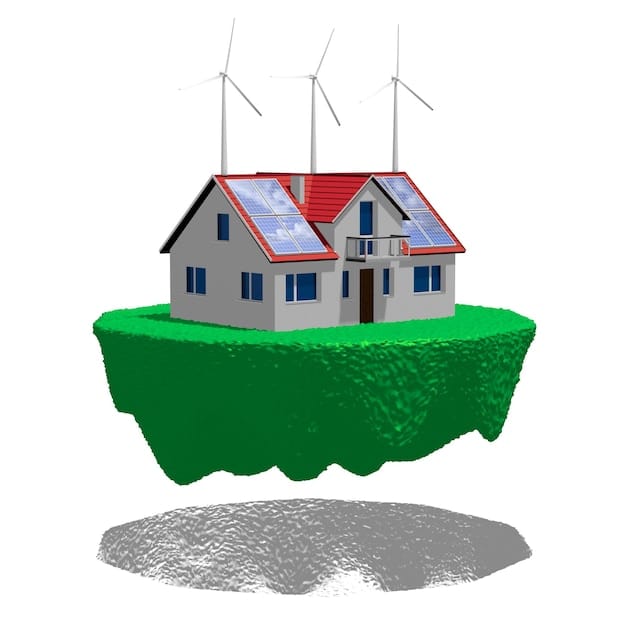Small-Scale Wind Turbines: Viable for US Homes in 2025?

Small-scale wind turbines represent a potentially viable renewable energy option for US homeowners in 2025, offering energy independence and reduced carbon footprint, though feasibility depends on factors like location, energy consumption, and initial investment costs.
Are small-scale wind turbines a viable option for homeowners in 2025? As the push for renewable energy intensifies, many are exploring ways to power their homes more sustainably. Let’s examine the potential, challenges, and what homeowners should consider.
Understanding Small-Scale Wind Turbines
To assess whether small-scale wind turbines are a good fit for homeowners, it’s crucial to understand what they are and how they function.
These turbines are designed to generate electricity for individual homes or small businesses, offering an alternative to traditional energy sources.
What Are Small-Scale Wind Turbines?
Small-scale wind turbines are typically much smaller than the large utility-scale wind farms. These turbines are designed to be installed on or near residential properties. They harness wind energy and convert it into electricity via a generator.
The generated electricity can then be used to power the home, reducing or eliminating reliance on the grid.
How Do They Work?
The functionality of small-scale wind turbines involves several key components working in tandem to convert wind energy into usable electricity.
As the wind blows, it spins the turbine blades. The rotating blades turn a generator, which converts the mechanical energy into electrical energy.
- Rotor Blades: Designed to capture the wind’s energy efficiently.
- Generator: Converts the rotational energy into electrical energy.
- Tower: Elevates the turbine to capture stronger, more consistent winds.
- Inverter: Converts the DC electricity generated by the turbine into AC electricity, which can be used to power homes and appliances.
In conclusion, understanding the basic mechanics and components of small-scale wind turbines is fundamental for homeowners considering this technology. This knowledge sets the stage for evaluating the feasibility and potential benefits for their specific needs and location.
Benefits of Installing Wind Turbines for Homes
The allure of having a personal wind turbine stems from several potential advantages. These benefits range from financial savings to environmental stewardship.
For homeowners, these advantages can be significant and transformative.

Cost Savings
One of the primary benefits is the potential for cost savings on electricity bills. By generating their own power, homeowners can reduce their dependence on the grid, leading to lower monthly expenses.
Over time, these savings can offset the initial investment in the turbine.
Environmental Impact
Wind energy is a clean, renewable resource. Using a wind turbine reduces your carbon footprint and helps combat climate change.
This can be particularly appealing to environmentally conscious homeowners.
- Reduced reliance on fossil fuels.
- Lower greenhouse gas emissions.
- Support for sustainable energy practices.
Energy Independence
Having a personal wind turbine offers a degree of energy independence. Homeowners are less vulnerable to fluctuations in energy prices and supply disruptions.
This can provide a sense of security and control over their energy needs.
In summary, the advantages of installing wind turbines in homes are multifaceted, encompassing financial, environmental, and energy independence benefits. These factors collectively make small-scale wind turbines an attractive option for forward-thinking homeowners in the US, particularly as technology advances and costs potentially decrease.
Challenges and Considerations Before Installation
Despite the potential benefits, installing small-scale wind turbines is not without its challenges. These considerations must be carefully evaluated before making a decision.
Understanding these challenges is essential for a successful implementation.
Initial Investment
The upfront cost of purchasing and installing a wind turbine can be substantial. This includes the turbine itself, installation fees, and any necessary permits or electrical work.
Homeowners need to assess whether they can afford this initial investment.
Location and Wind Availability
Wind turbines require consistent and adequate wind speeds to generate electricity effectively. Not all locations are suitable.
A professional wind assessment is often necessary to determine if a site is viable.
Maintenance and Longevity
Wind turbines require regular maintenance to ensure optimal performance and longevity. This can include inspections, repairs, and component replacements.

Homeowners should factor in these ongoing costs.
- Regular inspections.
- Component replacements.
- Potential repairs due to wear and tear.
Regulatory and Zoning Restrictions
Many areas have zoning laws and regulations that govern the installation of wind turbines. These restrictions can include height limits, noise restrictions, and permitting requirements.
Homeowners must navigate these regulatory hurdles, which can be complex and time-consuming.
In conclusion, while the benefits of small-scale wind turbines are compelling, potential challenges, particularly the initial investment, location constraints, and regulatory hurdles, warrant careful consideration. Homeowners should conduct thorough research and seek professional advice to determine if a wind turbine is a feasible and practical solution for their energy needs.
Cost Analysis: Is It Worth the Investment?
A crucial aspect of deciding whether to invest in a small-scale wind turbine is assessing the costs involved and determining if the long-term benefits justify the initial outlay.
A thorough cost analysis can help homeowners make an informed decision.
Initial Costs
The initial costs encompass the purchase price of the turbine, installation fees, permitting costs, and any necessary upgrades to the home’s electrical system.
These costs can vary widely depending on the size and type of turbine.
Ongoing Costs
Ongoing costs include maintenance, repairs, insurance, and any grid connection fees if the turbine is connected to the local power grid.
These costs should be factored into the overall financial analysis.
Return on Investment (ROI)
To determine the ROI, homeowners need to compare the total costs with the savings on electricity bills over the lifespan of the turbine.
Factors such as electricity prices, wind availability, and government incentives can affect the ROI.
- Calculate total initial costs.
- Estimate annual electricity savings.
- Factor in ongoing costs.
- Determine the payback period.
Government Incentives and Rebates
Various government incentives, tax credits, and rebates can help offset the initial costs of installing a wind turbine. These incentives can significantly improve the ROI.
Homeowners should research available incentives at the federal, state, and local levels.
In summary, a comprehensive cost analysis is essential for homeowners evaluating the financial viability of small-scale wind turbines. Considering initial and ongoing costs, potential savings, and available incentives will provide a clear picture of whether the investment is worthwhile in the long run. This analysis should be tailored to the individual homeowner’s specific circumstances and location.
Technological Advancements and Future Trends
The field of small-scale wind turbine technology is continually evolving, with ongoing advancements promising improved efficiency, lower costs, and easier integration into residential settings.
Staying abreast of these advancements is key for homeowners considering this technology.
Efficiency Improvements
Manufacturers are constantly working to improve the efficiency of wind turbines, allowing them to generate more electricity from the same amount of wind.
New blade designs and generator technologies are contributing to these improvements.
Cost Reductions
As the technology matures and production volumes increase, the costs of small-scale wind turbines are expected to decrease. This will make them more accessible to homeowners.
Innovation in materials and manufacturing processes will drive these cost reductions.
- Advanced materials for lighter, stronger blades.
- Improved generator designs for higher efficiency.
- Smart grid integration for better energy management.
Smart Grid Integration
The integration of wind turbines with smart grids allows for better management of energy production and consumption. This can optimize the performance of the turbine and reduce energy waste.
Smart grid technologies can also enable homeowners to sell excess electricity back to the grid.
Vertical Axis Wind Turbines (VAWTs)
VAWTs are gaining popularity due to their compact design and ability to capture wind from any direction. They are particularly suitable for urban and residential environments.
Ongoing research and development are focused on improving the performance and reliability of VAWTs.
In conclusion, technological advancements and future trends hold great promise for the small-scale wind turbine industry. As efficiency improves, costs decrease, and integration with smart grids becomes more seamless, these turbines are poised to become an increasingly viable and attractive option for homeowners seeking sustainable energy solutions. Keeping an eye on these developments will help homeowners make informed decisions about investing in this technology.
Case Studies: Successful Home Wind Turbine Installations
Examining real-world examples of successful home wind turbine installations can provide valuable insights and inspiration for homeowners considering this technology.
These case studies showcase the potential benefits and practical considerations.
Rural Home in Iowa
A homeowner in rural Iowa installed a small-scale wind turbine to reduce their reliance on the grid. The turbine generates approximately 80% of the home’s electricity needs, resulting in significant cost savings.
The homeowner also receives net metering credits for excess electricity sold back to the grid.
Suburban Home in California
A suburban home in California uses a vertical axis wind turbine (VAWT) in conjunction with solar panels. The VAWT complements the solar panels by generating electricity during periods of low sunlight, providing a more consistent energy supply.
The homeowner has reduced their carbon footprint and enjoys greater energy independence.
- Reduced electricity bills.
- Increased energy independence.
- Lower carbon footprint.
Off-Grid Cabin in Maine
An off-grid cabin in Maine relies entirely on a small-scale wind turbine and battery storage system for its electricity needs. The turbine provides a reliable source of power in a remote location, eliminating the need for costly grid connections.
The homeowner is completely self-sufficient in terms of energy.
Lessons Learned
These case studies highlight the importance of proper site assessment, turbine selection, and installation practices. They also demonstrate the potential for significant cost savings and environmental benefits.
Homeowners should carefully consider their energy needs, location, and budget when planning a wind turbine installation.
In summary, these diverse case studies illustrate the real-world success of small-scale wind turbine installations in various settings. By learning from these examples, homeowners can gain a better understanding of the potential benefits and challenges, enabling them to make informed decisions about adopting this sustainable energy solution. Success often depends on meticulous planning, professional installation, and a commitment to maintenance.
| Key Aspect | Brief Description |
|---|---|
| 💰 Cost Savings | Reduce or eliminate electricity bills over time. |
| 🍃 Environmental Impact | Lower carbon footprint and support renewable energy. |
| 🌬️ Wind Availability | Requires consistent wind speeds for effective energy generation. |
| 🛠️ Maintenance | Regular inspections and repairs are needed for optimal performance. |
Frequently Asked Questions
Modern small-scale wind turbines are designed to operate quietly. However, some noise is inevitable, especially in high winds. Proper siting and maintenance can minimize noise levels.
The lifespan of a small-scale wind turbine typically ranges from 20 to 30 years, provided it is properly maintained. Regular inspections and timely repairs are essential for longevity.
While it’s possible to DIY install a small wind turbine, it is generally recommended to hire professional installers. This ensures safety, compliance with regulations, and optimal performance.
The size of the wind turbine depends on your energy consumption and the average wind speed at your location. A professional energy assessment can help you determine the appropriate turbine size.
Yes, in most cases, you will need to obtain permits and comply with local zoning regulations before installing a wind turbine. Check with your local authorities for specific requirements.
Conclusion
In conclusion, while small-scale wind turbines present a viable option for homeowners in 2025 seeking renewable energy sources and potential cost savings, a thorough assessment of location, financial implications, and regulatory compliance is essential. Advances in technology continue to improve the efficiency and affordability of these systems, making them an increasingly attractive choice for sustainable home energy solutions.





